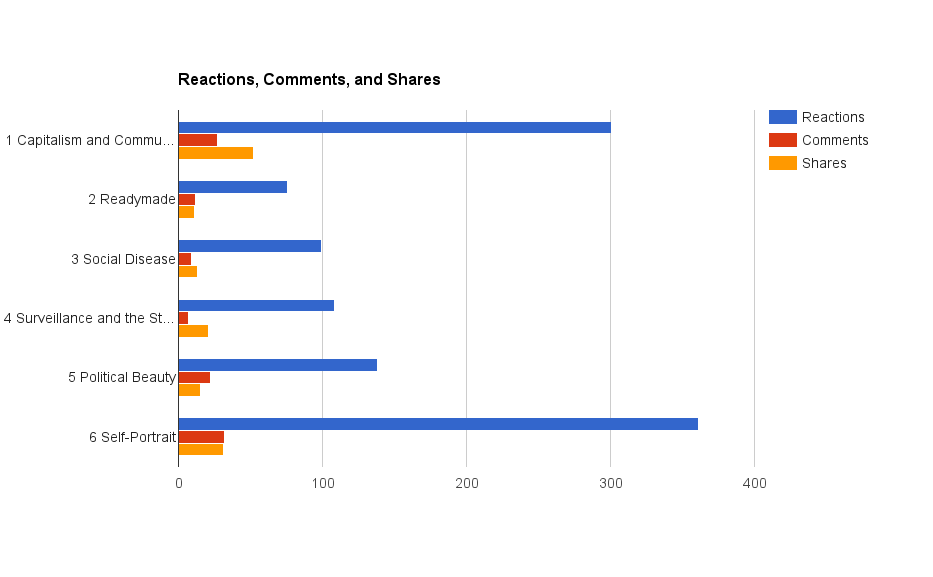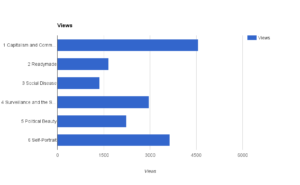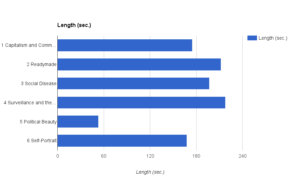technology By Jessica Warchall
When Ai Weiwei visited Pittsburgh in June for the opening of Andy Warhol | Ai Weiwei, he sat down in our six floor gallery and gave a 42-minute Facebook live interview with the New York Times. As I watched it, I thought, “Hey, we can do that….and more!” Facebook Live launched two months before the exhibition opened, and I had been thinking about how to best engage the platform.
The exhibition was installed thematically by floor, beginning on floor seven and working its way down through the galleries, just as the museum’s permanent collection galleries are installed. I put together a plan to highlight each theme, on each floor. A curator would talk for two minutes about a specific theme each Tuesday for six weeks at noon (our fans are online the most at noon).
I pitched this to our Associate Curator of Art Jessica Beck, and she was all for it! Each week, she chose to focus on either an artistic pairing or an exhibition theme more broadly.
After looking at what other cultural institutions were doing, I noticed two things: 1) the videos that used a lavalier microphone made for much better listening; 2) a steady camera makes for much better viewing. Armed with a mic and a tripod, we set off to start the series.*
After six Facebook Live videos, we’re starting to look at the analytics and learning a bit about what to do and not to do in the future.
Lighting
Lighting is key to a successful video. For our second video, the lighting in the gallery did not allow for a spotlight on the curator. Though the artworks were lit behind her, she was in in the shadows. That video received the fewest reactions and the fewest shares.
Wi-Fi
Check your Wi-Fi strength. The Wi-Fi is typically strong in most of our gallery spaces, with only a few dark spots. However, we happened to pick one of those spots on the second floor to record our fifth video. The video lasts for 53 seconds and abruptly cuts out. After this happened, we talked about what our next step should be. Move to a new gallery space and try again? Post a comment in the video that we’re fixing the problem and try again later? Post a comment apology and focus on next week?
We chose the latter. With a simple, “Sorry the live video cut out! Wifi issues in the gallery.,” we were off to plan for our next, and final, Andy Warhol | Ai Weiweibroadcast for the following week. Rather than broadcast from the museum’s education studio The Factory to talk about Ai Weiwei’s cat wallpaper, we changed our plan and recorded again on the second floor, this time talking about a different artwork, but ending on the same artwork we tried to include in the previous week’s video.
Time limit
The original plan suggested a two-minute video format, thinking that would be long enough to tell a rich story, but short enough to not lose an audience. Looking at our audience retention analytics, for five of the videos, we saw between 7–10% retention. The video that cut out after only 53 seconds has a 25% retention, which suggests that a shorter live video might be more effective for our audiences.
Though we tried to keep the videos to two minutes, even doing run-throughs before we went live, storytelling is fun, and we ended up with our videos averaging just over three minutes in length (not including the video that was cut short).
Promotion
For this series, I chose not to heavily promote it. The first live video was not promoted in advance at all, in case it went terribly wrong. Later videos were promoted on Facebook with individual posts and comments within the videos, as well as on Twitter with images and links. In fact, one of the promotional tweets for the final live video received 690 engagements, though I think it might have been more for the image attached rather than the message.
Next is a deeper dive into the analytics and upping the production value. We’ll start thinking about such things as audience retention, promotion, and purchasing a light kit. We’ll also think about experimenting with answering live comments and questions from our viewers.
If you haven’t experimented with Facebook Live, develop a strategy and go for it. It’s a relatively low impact storytelling platform with the potential for big results. We will be using the platform again, and hopefully more frequently, as we discover more of what works and what our fans want to see and hear.
*We purchased a RØDE smartLav+. The sound quality was very good, even when the galleries were loud. We will probably purchase an extension cable in the future. We purchased an Accmor Tablet Tripod Adapter, which did not have an adjustable depth so the iPad occasionally slipped out of the adapter.




